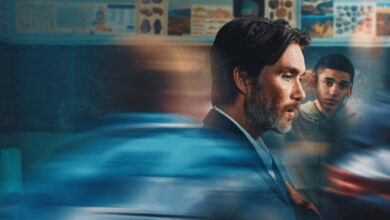Avatar: The Way of Water Review: Offer A Real Feast For The Eyes And Great Emotion Merits and Limits Of A Cinematic Poem
Cast: Sam Worthington, Zoe Saldana, Sigourney Weaver, Stephen Lang and Kate Winslet
Director: James Cameron
Where To Watch: In Theaters
Filmyhype.com Ratings: 4.5/5 (four and a half stars)
It has been awaited and desired for 13 years but also mocked and underestimated for just as long. As if the importance and impact of a film like Avatar: The Way of Water– a new film by James Cameron – could somehow be diminished by the passing of the years. When in reality the exact opposite is now evident because the more the wait increased, the more this Avatar: The Way of Water became something much more important: no longer just the second chapter of a saga that at this point still promises to be more epic and grandiose than we could have imagined in 2009, but also a sort of symbol/manifesto film of the importance and uniqueness of the cinematic experience lived in theaters.
![]()
It is for this reason that we want to start this review of Avatar: The Way of Water by specifying that we have seen the film in 3D, with a giant screen and perfect audio, with the audience around constantly amazed and in suspense. We saw it as a film that aims to transport us to an alien universe, to make us forget our world, and our daily lives, and to transfer our essence into the alien body of the Na’vi deserves to be seen. Because cinema is exactly like that marvel, halfway between technology and magic, that the Avatar saga tells us. And Avatar 2, like the previous film, is exactly what cinema should be.
Avatar: The Way of Water Review: The Story Plot
We can start talking about the most problematic aspect, the one that made the first film an incredible success, but which has always been defined as the weak point of the Avatar project: the plot. Too formulaic and simple, based on archetypes that belong to the dawn of storytelling, Avatar seemed more memorable for the visuals than for the story it wanted to tell. This second chapter had the double duty of making those disappointed by the first chapter change their mind and expand the narrative of the saga, laying the foundations for a long story but in any case, resulting closed in on itself.
The plot of Avatar takes up the story of Jake Sully (Sam Worthington), now complete Na’vi, and Neytiri (Zoe Saldana) who have become parents: three biological children, Neteyam, Lo’ak and the little Tuk, a now-adolescent adopted daughter named Kiri, born from the avatar of Dr. Grace (Sigourney Weaver in the first chapter and here the body and voice of the young Na’vi), and a human adolescent who grew up with them called Spider. Life in the forest of Pandora seems to proceed in harmony, until the humans of the RDA, led by the evil Colonel Quaritch, whose memories were recombined in the body of an avatar after his death in human form in the first chapter, return to Pandora to bring destruction and, above all, take revenge on Jake.
The Sully family is therefore forced to flee from their people and find refuge in a population of Na’vi with a different culture called Metkayina. Here the Sullys will have to learn the customs of the marine people, who do not welcome the arrival of these different and sought-after Na’vi but also to manage a rift in family relationships, which will gradually become wider and wider.
![]()
Just like the previous film, the plot is deliberately essential, precisely because James Cameron’s purpose is to show us this extraordinary alien world and the wonders it hides. The director’s intentions are clear right from the start, so much so that after a first part entirely set in the regions rich in vegetation that we know well, he completely abandons the well-trodden and well-known terrains to throw himself (literally) into an ocean populated by creatures as bizarre as they are narcotics. So, what is the use of the plot when in reality the spectacle, the sense of wonder, comes from the images themselves? From the creation not of an intricate plot, but of an entire world with its flora and fauna, with its mythology, its language, and its rules?
Avatar: The Way of Water Review and Analysis
Of course, in a historical moment in which the viewer – between almost infinite film sagas and television series at will – is now almost a slave to increasingly intriguing and surprising narrative developments, Cameron takes risks like never before. And he does it above all because he gives in to the temptation of a long film saga, despite not having from him the affection of the public for the characters or who knows what twists and turns ready to amaze. He ventures by staking everything on the quality and uniqueness of his work, on the awareness that even images alone can win the hearts of viewers as it has always been since the dawn of cinema.
And once again there will certainly be those who will complain about having spent a good part of the three hours of duration watching a sort of Superquark special on an alien planet: on the other hand, there is no doubt that Cameron is once again putting the focus of his film his ecological philosophy and his interest in the environment, nature and in particular the sea. At the same time, however, he inserts a new theme into his film, which goes exactly hand in hand with the one mentioned above: in fact, the family is at the center of this Avatar 2. A universal and certainly not original theme, but it completely changes the perspective of the protagonist Jake Sully, and therefore ours too: now a mature and thoughtful man, no longer daredevil and cheeky as in the first, Jake has an exactly opposite role and attitude in this sequel.
We have mentioned it, so let’s see whom this new family of characters but also of actors is made up of: as known Sam Worthington, Zoe Saldana and Stephen Lang take up the same roles as in the previous chapter (even if the last one holds some surprises); while in the case of Sigourney Weaver, the great actress “transforms” into Kiri, the teenage adoptive daughter of the protagonists, actually half human and half Na’vi and with mysterious origins. In addition to Kiri, Jake and Neytiri also have three children: the eldest son Neteyam (Jamie Flatters), the second and more rebellious Lo’ak (Britain Dalton), and the little and very sweet Tuk (Trinity Bliss). To them must be added another teenager, the human “Spider” (Jack Champion), born and raised on Pandora and therefore an integral part of this large extended family. As already mentioned, the whole first part shows us and tells us about these characters, and their family dynamics; then the film changes and, we could say, shows its true nature.
The action moves above and below the surface of the sea, to the Metkayina clan who live on the coral reef: it is here that we meet Chief Tonowari (Cliff Curtis) and his wife Ronal (Kate Winslet) and many other characters who make up the new tribe. And it is here that, exactly as it happened to us for the first time in 2009, we are once again seduced by Pandora, by her beauty and by her dangers. Because through the eyes of these Na’vi accustomed to luxuriant vegetation and majestic trees, we see what the sea hides and we know “the way of water”. And it is here that the film and its director give their best, because never before in the history of cinema can we say that we have the sensation of being underwater. And the feeling is as amazing as it is natural, also because Cameron doesn’t use shortcuts.
![]()
On the other hand, if there is a director who even in the past has always shown that he knows how to shoot in water, it is James Cameron: already with Titanic, but also with the previous The Abyss, the director has shown a deep attraction towards the depths of the oceans and has overcome a thousand difficulties, sometimes even risking more than necessary, to bring his spectacular and even action cinema below sea level. The result this time too, indeed even more this time, is truly amazing: James Cameron is now able to shoot underwater with an ease and freedom of action that other directors seem not to have acquired even on the surface. At the risk of looking bad, we cannot, for example, avoid saying that any action scene in this film is probably superior to most of those we have seen in the last decade: for cleanliness and clarity, for the camera movements and direction of the actors, but also choreographies themselves or use of the sets. Even worse, and far more useless, would be to compare the underwater scenes of Avatar 2 with those of any other film, even recent ones (Did someone say Wakanda Forever?).
But, on the other hand, James Cameron’s cinema was immersive like a few others we had already known for some decades. However, it is impossible to notice how, even today, no one has an equally clear idea of how to use 3D: we are not only talking about the final result which, obviously, also has an important influence on the budget; we’re talking about a directing concept that goes beyond the classic one and that aims at a depth of fields like no other film or director has ever managed to do. And if already with the excellent 3D conversion of Titanic we had guessed how powerful such a tool could become in the hands of a master of action, in the final half-hour of this Avatar: The Way of Water it is evident that Cameron at moment it has no rivals. On the other hand, as demonstrated by the entire technology sector of the film.
This is what we also said thirteen years ago for the first Avatar, we are aware of it: but we could not expect anything different from Cameron, except to be amazed. And he succeeded once again. Despite the very high expectations, despite the preventive criticisms, the film industry is more in crisis than ever. James Cameron on the other hand goes straight on his way, even going against the trend and betting everything on the magic of cinema and the unique emotions that he can arouse. Because you can’t be afraid of streaming and cinema from home when what you care about is only taking the viewer light years away from the Earth. And to discover that there, perhaps, a little humanity remains.
James Cameron continues along the path he has always taken, never denying his personality but rather renewing it with the awareness of maturity. His Avatar: The Way of Water intends to approach a narration that passes above all through images, a choice that today appears almost in contrast with the consolidated contemporary formulas, where dialogue and exposition through the word count more than the meaning of the images. In Avatar 2’s best moments, one shot is enough to tell everything: the development of the plot, the thoughts of the characters, the emotional transport, and life on Pandora… The narration passes above all through the eyes and the looks (which underlines once again how the visual effects are state of the art:
The montage plays on alternating narratives and has to bring together many characters and different stories, linking them emotionally or figuratively. Especially in the central part, the target is not always hit, giving the sensation of a somewhat fragmented narration, always with a high pace but a little dispersive (even if, as we already said a few lines above, the third act binds everything together and it does it incredibly well). One could say that this sequel is almost a remake of the first chapter, set in water instead of in the forest, but it is not. Surely Avatar: The Way of Water does not hide its nature as a second chapter, stimulating certain dynamics and taking up, especially from a musical point of view, certain themes that can give the effect of déja-vu, especially when inserted in certain scenes. However, it is a conscious and deliberate choice. On the other hand, we expect rhymes in a poem.
![]()
In reality, it is the new point of view, especially about historical characters, which makes Avatar 2 the most natural and best continuation of the saga, in the same way as the development and new starting point of a franchise that yes, we need. Because Avatar: The Way of Water responds to a desire, that of exemplifying the grandeur and uniqueness of cinema in an almost religious way. A gaze is an act of love. And then leaving the room and being able to think that no, there is nothing comparable to this type of experience, to this type of emotion. No, there’s no story.
Avatar: The Way of Water: Technical Analysis
As we can well imagine, the real spearhead of James Cameron’s film is certainly the technical side, which makes us immerse ourselves in fantastic landscapes of mammoth dimensions. Let’s start by analyzing 3D, something that has always divided the public into supporters and non-supporters and which, due to current technological shortcomings, has not yet taken off either on the big screen or on home video. The 3D of Avatar 2 is something that borders on the superlative in terms of rendering and final effect. It’s not just that simple sense of depth but a real feeling that in some scenes something goes off the screen and enters the room.
The initial impact is really pleasant, then the eyes and brain get used to it but with the spectacular 3D effect, especially in some sequences, we have to say that it remains even at the end. And despite the 3 hours and more of film, at least personally, no headache at the end of the screening. Spectacular and truly high level is also the rendering of the CG, the action scenes, and the perfect integration between “real elements” (human beings) and the unreal present in the scene. The scenographic rendering is perhaps the thing that most amazed us a bit as it was for the first film, thanks to the very high quality of the 3D models, the management of the lights and the brilliance of the chromatic scale.
![]()
Avatar 2 is a visually spectacular sci-fi that owes much of its success to the technical sector capable of masking, at least initially, the holes in a tired script that offers very little compared to the previous chapter. Yes, because if we discover the work of James Cameron by removing this “beautiful bodywork” (which is what acts as a lark’s decoy) there is very little left on an emotional and script level. Sure, there are numerous narrative cues but absolutely nothing surprising.
Maybe the ending will also move you but for most of the story, there is not much to say in terms of plot and concepts. A film that could have been better than it is, which despite reaching full sufficiency has nothing to do with that epochal story that many perhaps expected. It seems to fall more disastrously on the commercial blockbuster side of blockbusters at the expense of narrative quality and we are truly sorry and a little disappointed about this. However, a film recommended to a large audience is to be seen strictly on the big screen, possibly in 3D.
Avatar: The Way of Water Review: The Last Words
With Avatar: The Way of Water James Cameron offers his most mature film, without denying his personality. This sequel to the 2009 film intends to expand its narrative, without renouncing the simple and effective elements that made it a success. 192 dense but engaging minutes, which offer a real feast for the eyes and great emotion. A film for the big screen which, despite some slight sense of déjà vu, shines and proves to be one of the most incredible visions possible.
Avatar: The Way of Water is a sequel as spectacular and perfect from a technical point of view as narratively and thematically consistent with what was its predecessor. Which means that it carries with it the same potential flaws and critical issues and therefore very unlikely to change the mind of the (many) detractors of the saga. But considering the billion-dollar receipts of the 2009 film, we are sure that once again, for millions of viewers from all over the world, James Cameron’s new film will prove to be a unique and unforgettable experience. Of those that make us love the cinema and constantly remind us why we can’t do without it.







